EUPHORBIA MILII CULTIVATION
The Euphorbia milii hybrids in cultivation are a domesticated lot and though technically succulent, they require growing conditions more like tropical foliage plants than typical Cacti & Succulents.The Euphorbia milii hybrids in cultivation are a domesticated lot and though technically succulent, they require growing conditions more like tropical foliage plants than typical Cacti & Succulents.
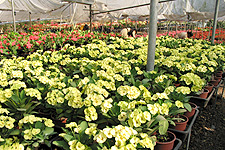 |
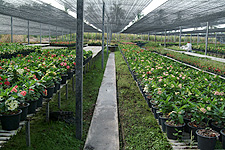 |
| On left, Euphorbia milii hybrids in full bloom at Tropica Nursery in Mumbai, India. | A view of one of the best Euphorbia nurseries in Bangkok. |
In fact one of the reasons I think many growers in Holland were unsuccessful with the Thai hybrids is because they grew them like they grow their Cacti & Succulents- too dry and too close.
Euphorbia hybrids are truly tough plants and can take just about anything including relatively dry or overly wet conditions, temperatures between 4 and 40+ deg C, part shade to full sun and a variety of growing media. However, to give of their best they do require moderation in all the above (they can survive lousy conditions but don't enjoy them!).
Euphorbia milii are some of the few plants that can be repotted lower than the original soil level without any problems- this becomes necessary with some grafted Thai hybrid plants- planting them lower hides the union and since plants often get too tall, it makes for a more proportional pot plant.
The Thai growers use essentially the same media for Euphorbia that they do for Adenium, maybe a little richer with more manure and dry, mature Samanea saman (Rain tree) leaves.
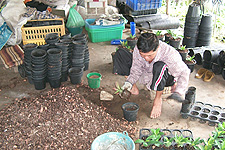 |
A Thai grower pots up grafted Poysean into larger pots: media is a combination of coconut coir, coconut husk chunks, clay, manure and leaves of the deciduous rain tree (Samanea saman). |
We too use the same media that we use for our Adeniums, with some extra manure for added nutrition. The concept is to have moisture retaining yet well aerated and open media. Euphorbia milii definitely needs higher levels of nutrition than Adeniums, probably because of their constant blooming but like Adeniums, they will give soft and vigorous vegetative growth if fed too much Nitrogen (especially in Ammonium form) and/or excessive Phosphorus.
For the bigger hybrids, especially the Poysean, a relatively large container is good for healthy growth and really essential when the plant gets tall and top heavy. In fact I know of few plants that seem to tolerate and even prefer over-potting as much as the Thai Poysean hybrids.
For the more compact hybrids, small containers help in keeping the plant growth in check. In our own breeding program, we have always selected for plants that grow well in proportion to their containers. Our hybrids will often flower freely in 6 cm square pots or even in plug trays.
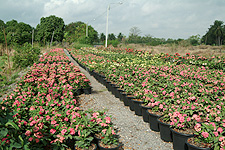 |
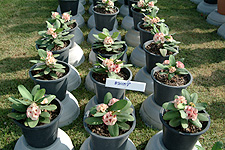 |
| Poysean in Thailand: plants are almost always over potted at sale time- they seem to tolerate it very well. | |
Plastic pots are used universally for Euphorbia milii and work perfectly as long as the media drains well and drainage holes are open.
Euphorbia milii hybrids are flexible in their watering requirements. As long as the media is open and well drained, they can be watered regularly. As with any pot plant, when watering its best to do so thoroughly, till a little comes out through the drain holes. We rarely see rotting in these plants, even if heavily over watered but its best to allow the media to dry out somewhat between watering.
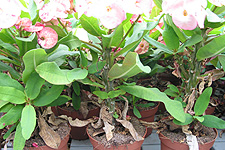 |
Poysean trial by a large Dutch grower of cacti & succulents- plants were kept too dry and too close, with poor results. The grower decided the crop wasn't good for him. |
Though our plants are generally watered by hand held watering wands, this has some disadvantages: water tends to collect in the flowers- more in some selections with cupped flowers than in others- and when mixed with the copious nectar tend to discolor the central portion. If your water is hard, it tends to show as white deposits on flowers and leaves. Finally, during the monsoon, with extremely high humidity levels, the water on the leaves and flowers leads to botrytis or powdery mildew, especially if the leaves and flowers are closely bunched up.
For these reasons we are trying to get drip irrigation installed to water all our pot plants.
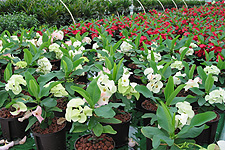 |
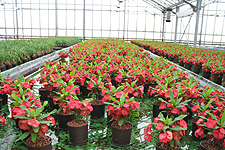 |
One interesting fact is how well at least the Thai hybrids do in hydroculture -as the pictures above show; easily the best grown Poysean plants I have seen (anywhere in the world) are at this hydroponics grower in Holland.
Euphorbia milii are amongst the toughest plants in cultivation and can take extreme conditions and still look good. The Tropica Hybrids developed by us combine this toughness with the qualities needed in a modern color pot plant , giving us a new crop that can be grown easily and with minimum environmental impact any where in the world.
Though definitely a tender perennial, this crop can take quite low temperatures without damage. Since we are extremely tropical it's not possible to judge the minimum temperatures it can take but the plants grow right through our winter when night temperatures go below 10 Deg C and it also grows and flowers at our high altitude farm at over 1200 meters where it takes 4 Deg C and below in winter.
On the higher side, we regularly go to 42 Deg C with low humidity in summer and the plants have few if any problems at all.
On the whole, Euphorbia milii seem to be indifferent to humidity levels but extremely dry conditions are best avoided if possible. In Thailand, Poysean are often grown surrounded by water in canals but this is due to their system of reclaiming paddy land for other crops than due to the needs of this crop.
Under our conditions of intense sunshine and hot temperatures, we need 30% shade over the plants. Under less harsh conditions, they can do with little or no shade. On the other hand, shade levels over 50% will lead to poor flowering in most clones. The hybrids with more Euphorbia lophogona influence seem to tolerate higher shade levels.
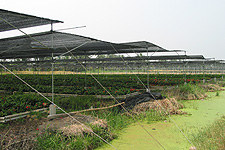 |
Large scale Poysean production just outside Bangkok, all under 50% shade net. |
When used as pot plants the hybrids need at least a few hours of direct sun with bright light the rest of the day. They would do well on or outside windowsills or balconies facing East, West or South.
Despite doing everything right, Crown of Thorns will sometimes flower poorly or not at all, especially in urban locations- in such cases check that there are no bright lights on the plants at night (such as street or security lights). These disrupt their flowering cycles enough to prevent flowering.
A modest amount of rain is well tolerated. However, dried flowers and leaves should be scrupulously cleaned before periods of prolonged wetness. Plants with thick, bushy growth habit as well as large masses of flowers will hold water for long periods. These tend to develop fungal problems if the water persists for days, as it would during the monsoon. Thinning such growth as a preparation for the rains along with general cleaning helps prevent this. Any material that is turning brown or rotting should be cut off and discarded immediately.
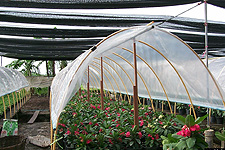 |
Temporary plastic cover used by a grower in Bangkok to protect plants during the wet season. Bangkok does not have the prolonged wet monsoon season like parts of India or Taiwan and showers are usually of short duration with sunshine in between. |
Problems during the monsoon can get serious for commercial growers because disease can run rampant through closely spaced plants. We grow all our plants under simple plastic structures for rain protection. For hobby growers it is less of a problem and will rarely kill a plant. Its better to keep plants out of full rain if possible.
Fungicidal drenches beginning at the onset of the monsoon season and applied monthly are very helpful. Try alternating a Metalaxyl containing product such as Ridomil with Bavistin (containing Carbendazim) with another group such as Alliette to prevent resistance.
We are also getting good results with bio-control agents such as Trichoderma species and Bacillus subtilis but do not mix these (especially Trichoderma, which is itself a fungus) with fungicides.
These plants require considerable amounts of nutrients, certainly more than Adeniums. This nutrition is best provided with Nitrate Nitrogen as an excess of Ammonium N and Phosphorous leads to rapid elongation of stems and soft growth.
Macronutrients need to be given on a regular basis- we now use a complete mix, which we blend ourselves, with all 12 nutrients needed by plants in the liquid feed.
Micronutrients are also needed, especially in soilless media like ours. One important consideration is the sensitivity of Euphorbia milii to Boron. If used at levels common in commercial micronutrient mixtures, toxicity will often be seen. We use a mix that does not contain Boron and add this element separately when needed.
Euphorbia milii hybrids pose several problems when it comes to pruning. One is the obvious problem with the milky sap- not only is it toxic and can be dangerous if it gets into ones eyes but it sticks to and spoils the cutting instruments. For this reason, we use cheap knives for pruning as well as grafting. These knives, apart from being cheap, are easy to clean and sharpen compared to secateurs.
There are two basic concepts of pruning any plant and have diametrically opposite results: branches can either be cut back somewhere along their length, to increase branching from axillary buds or individual branches can be removed at their base to allow more air and light into a thickly growing plant, a process aptly called thinning.
Most commercial Euphorbia milii hybrids are selected for natural branching and so rarely need to be pruned. The Thai Poysean hybrids are the exceptions- they can grow vigorously and soon become too big and tall for the pot. The obvious answer is to cut back at an appropriate height but this does not always work- very often, the base will not sprout any new buds and just stand there, sometimes for years. A solution is to make sure there are some axillary buds sprouting before cutting the top. In this case there will be no problems and the buds will sprout after the top is cut back.
The more bushy hybrids may need to be thinned with time- thin, weak or excess branches should be cut at their point of origin- this is where the tissues are most compact and will heal the best.
Euphorbia milii hybrids respond well to repotting. Use a larger pot each time but if repotting in the same pot some of the old media may be removed and replaced with fresh media.
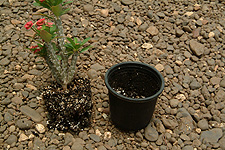 |
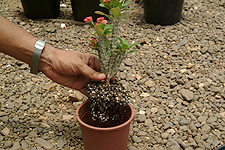 |
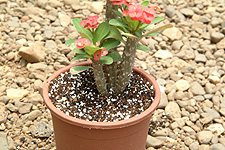 |
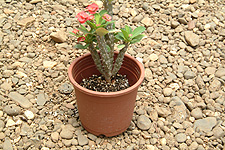 |
| Clockwise from top left: Seedling in a #2 pot is quite large- the root ball also shows poor roots and soggy media. Excess media is removed and seedling repotted into a #3 pot. Note the narrow stem just above the root ball, typical in seedlings and not seen in cutting grown plants. Lower pictures show how the plant is buried quite deep and new media is now well above original soil line- this helps stabilize the plant, makes it look more compact and, surprisingly, seems to do no harm to Euphorbia milii plants. | |
The best time to repot is summer, when vegetative growth is strong. When repotting, one may lower the plant and allow the media to come higher than the original level. Surprisingly, this causes no problems and is useful when the plant is a little lanky and too tall for the pot.
Annual repotting helps with the more vigorous Thai cultivars. Once the plant is big enough, repot every two years. Ultimately most Euphorbia milii plants will look tired and weak and are best discarded or planted in the ground in frost free areas. Unlike Adeniums, which can almost become a family heirloom, Euphorbia milii plants have a relatively finite life span.

© Copyright Tropica Nursery 2025. All Rights Reserved.
Maintained by MiracleworX Web Designer Mumbai